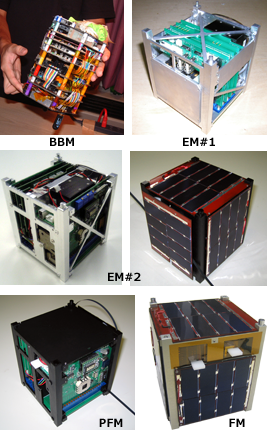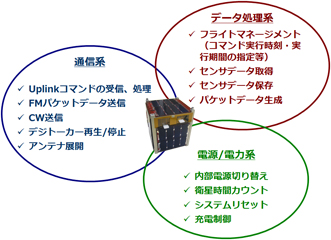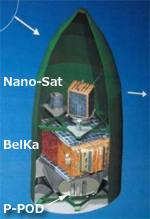SEEDS
 SEEDS (Space Engineering Education Satellite) is the first satellite that Nihon University launched. SEEDS is a CubeSat with 10cm cube in dimension and 1kg in weight. The summary of development and launch of SEEDS is as follows:
SEEDS (Space Engineering Education Satellite) is the first satellite that Nihon University launched. SEEDS is a CubeSat with 10cm cube in dimension and 1kg in weight. The summary of development and launch of SEEDS is as follows:
| Size, Mass | 10cm cube, 1kg |
| Project kick off | spring 2001 |
| BBM | summer 2002 (launch of Open Class Cansat in ARLISS) |
| EM#1 | begining of 2003 |
| EM#2 | end of 2003 |
| FM complete | September 2004 |
| Frequency |
| Downlink(CW,FM) | :437.485MHz |
| Uplink(FM) | :140MHz band | |
| MOU of launch | November 2003 (CalPoly) |
| Export | September 2004 (to CalPoly) |
| Launch date | 01:34 July 27, 2006 (local time. 04:34 JST) |
| Launch vehicle | Dnepr-LV7 (Kosmotras, Russia) |
| Launch site | Bikonur Cosmodrome (Kazakhstan) |
| Launch configuration | Cluster launch of 18 satellites including 14 CubeSat (Primary satellite: BelKa of Belarus) |
| Satellite separation system | P-POD (provided by CalPoly) stored with nCube (Norway) and HAUSAT-1 (South Korea) |
| Launch result | Failure caused by trouble of 1st engine of rocket |
| Budget | budget supplied by our unievrsity, and Grant for private university by MEXT |
 We exported SEEDS to CapLoy by hand-carry in September 2004, and conducted the acceptance test (vibration test, bake out, fit check with P-POD, etc.). SEEDS was going to be stored into P-POD with nCube of Norway and HAUSAT-1 of South Korea, and be launched by Dnepr rocket. We took great care of the satellite system and the storage into P-POD because the trouble of SEEDS in the P-POD may result in the trouble of other two satellites.
We exported SEEDS to CapLoy by hand-carry in September 2004, and conducted the acceptance test (vibration test, bake out, fit check with P-POD, etc.). SEEDS was going to be stored into P-POD with nCube of Norway and HAUSAT-1 of South Korea, and be launched by Dnepr rocket. We took great care of the satellite system and the storage into P-POD because the trouble of SEEDS in the P-POD may result in the trouble of other two satellites.
After that, SEEDS was unexpectedly kept in the clean room of CalPoly for one year and nine months.
 The right figure illustrates the function of the bus system of SEEDS. The bus system of SEEDS is quite simple and it was develoed undet the following concept:
The right figure illustrates the function of the bus system of SEEDS. The bus system of SEEDS is quite simple and it was develoed undet the following concept:
- One MPU (master computer) controls the whole system of the satellite
- The MPU that receives the FM uplink command and manages the operation mode is the master computer (We call it "FMR", which means FM Receiver and Flight Management computer).
- FMR can reset other MPU according to the uplink command from the ground station. The automatic periodic rest system of MPU using watch dog timer is not installed. The automatic reset system by detecting the single event by radiation is not installed, too. Instead of those reset systems, the MPU tolerant to the radiation, i.e. PIC, is used for every MPU.
You may feel this concept is quite risky. If FMR hangs up by software bug or radiation effect, the whole satellite system hangs up. It is commonly accepted method (common sense) in the development of nano-satellites less than 10kg that the on-board MPU should be periodically reset, but we did not adopt this system for SEEDS because we were afraid of the bug or any trouble at the reset system and single event detection system. So the member chose the above concept. This concept has not caused any trouble because PIC has high tolerance to the radiation. This concept is suceeded to SEEDS-II and SPROUT (SPROUT has two FMR for redundancy, and each FMR can reset the other FMR).
|
SEEDS is a satellite for education fo space engineering, and its mission is quite simple as in the following tanle:
| Minimum Mission | Downlink of housekeeping data by CW signal |
| Middle Mission | Downlink of sensor data by FM packet (AX.25 protocol)
Attitude analysis using sensor data (gyro, geomagnetic sensor, and others)
|
| Advanced Mission |
Downlik of voice by digi-talker
Downlink of analogue image by SSTV signal
|
Thie right photo is a slide show of the snapshot of developmen of SEEDS in 2004.
|
|
|
|
The launch of SEEDS was scheduled at November 2004, but it delayed about 2 years. During the waiting time, the CubeSat groups including us discussed the order of launch. There was the other CubeSat group that was coordinated also by CalPoly. The launch of that gourp was scheduled after our group. However, the delay of the development of the primary satellite of our launch, they discussed to change the launch slot and launch the other group first and our group second. After the discussion, our group was launched first as scheduled. In the result, the launch of our group was failed and the other group scceeded. Sometimes such a situation happens in this world.
After all, we could not achieve the mission success, but the experience of the development of a flight model of a satellite including the on-board software was very helpful for the development and success of SEEDS-II. Actually, we found lots of points for modification of the on-board software during the development of the ground station software.
|

|
|
 |
|

 SEEDS (
SEEDS ( We exported SEEDS to CapLoy by hand-carry in September 2004, and conducted the acceptance test (vibration test, bake out, fit check with P-POD, etc.). SEEDS was going to be stored into P-POD with nCube of Norway and HAUSAT-1 of South Korea, and be launched by Dnepr rocket. We took great care of the satellite system and the storage into P-POD because the trouble of SEEDS in the P-POD may result in the trouble of other two satellites.
We exported SEEDS to CapLoy by hand-carry in September 2004, and conducted the acceptance test (vibration test, bake out, fit check with P-POD, etc.). SEEDS was going to be stored into P-POD with nCube of Norway and HAUSAT-1 of South Korea, and be launched by Dnepr rocket. We took great care of the satellite system and the storage into P-POD because the trouble of SEEDS in the P-POD may result in the trouble of other two satellites.
 The right figure illustrates the function of the bus system of SEEDS. The bus system of SEEDS is quite simple and it was develoed undet the following concept:
The right figure illustrates the function of the bus system of SEEDS. The bus system of SEEDS is quite simple and it was develoed undet the following concept:


